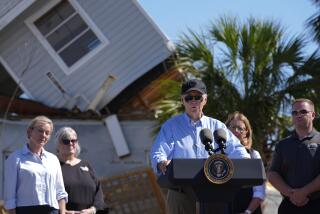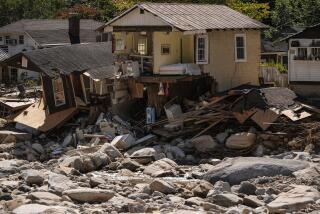Bush Seeks $1.5 Billion More to Bolster Levees
NEW ORLEANS â President Bush, under increasing pressure to demonstrate his determination to rebuild New Orleans, asked Congress on Thursday for an additional $1.5 billion to make the cityâs protective levees stronger than they were before they burst during Hurricane Katrina.
Donald E. Powell, the White Houseâs coordinator for Gulf Coast rebuilding, said the money would pay to line the levees with concrete and stone and close off three canals that were the source of about half of the flooding.
âThe levee system will be better and stronger than it ever has been in the history of New Orleans,â Powell said. âIf a hurricane such as Katrina ever visited New Orleans again ... there will be some flooding, but no catastrophic flooding.â
Yet officials at the Army Corps of Engineers, which oversees the levees, said that even with the improvements described by the White House to strengthen the system, it could not withstand hurricanes as powerful as Katrina.
The levees failed as Katrina sent a massive storm surge coursing through the low-lying cityâs drainage and shipping canals. The flood killed hundreds of residents who had chosen not to evacuate or were unable to get out. It damaged or destroyed about 250,000 homes and businesses.
The levees are seen in New Orleans as a linchpin to recovery. The cityâs efforts to repopulate have stagnated as thousands of families and business owners have decided they cannot begin the process of rebuilding until they hear assurances that the levees will be stronger than they were before the storm.
Until Thursday, Bush had committed only to plugging holes in the levees and bringing them, effectively, back to their condition before the storm.
Louisiana officials said they would continue to fight for more extensive federal funding to strengthen the regionâs storm protection.
Gov. Kathleen Babineaux Blanco called the $1.5 billion a âdown payment.â And one displaced New Orleanian said she would have to be âstone crazyâ to believe that the pledge was enough protection from big storms.
The levee announcement by no means solves the dilemma facing many residents whose homes or businesses were destroyed. Officials are still trying to determine, for instance, whether entire pockets of the city must be bulldozed.
Federal engineers cautioned that the Bush package was enough to make the levees as strong as they were supposed to be before Katrina struck. Preliminary investigations show that design and construction flaws appear to have contributed to their collapse.
But officials were hopeful that the presidentâs pledge would begin to reassure residents and business owners who have been hesitant to return.
âWe understand that the people of New Orleans need to be assured that theyâre going to be safe when they get back home,â said Homeland Security Secretary Michael Chertoff.
New Orleans Mayor C. Ray Nagin said he was heartened by Bushâs decision. He said Congress appeared to have shaken off its âKatrina fatigueâ and was poised to deliver what he called a âholy trinity of recoveryâ -- stronger levees, tax incentives and initiatives to address the cityâs severe housing shortage.
âThis commitment, this action today, says: âCome home to New Orleans,â â he said.
City Council member Jay Batt called the strengthening of the levees the most crucial hurdle facing the city.
âYou are going to see a lot of activity and people making plans to relocate as a result of this,â Batt said. âThis sends a strong signal to everybody in New Orleans that it will be safe to come home, to rebuild, to reinvest.â
Reaction among residents whose homes were destroyed was more muted.
Many in New Orleans have pushed for a storm-protection system that would guard against a Category 5 hurricane, the most powerful level of storm. Katrina weakened to a Category 4 hurricane shortly before landfall and may have further weakened as it moved into New Orleans.
The more ambitious program would include rescuing the decimated wetlands and barrier islands south of New Orleans, which had served as a buffer against storms before they were washed away, as well as enormous offshore floodgates. State officials have estimated that full-fledged storm protection could cost $30 billion or more.
White House officials pointedly declined to say Thursday whether the $1.5-billion plan would protect against a Category 5 storm.
âI donât think that we can design a system that will compete with Mother Nature,â Powell said.
Thatâs not good enough for Valentino Lite II, a retired Army officer whose home in the Gentilly neighborhood was destroyed. He is now living in a Baton Rouge home that he bought for his parents years ago.
âIt sounds like a lot, but $1.5 billion ainât even a drop in the bucket,â Lite said.
Without assurances that the levees can withstand a more powerful storm, Linda Garth-Llopis, whose Lower 9th Ward home was destroyed, said she would never return to the only neighborhood sheâs ever known.
When she was 20, Garth-Llopisâ home was destroyed during the flooding that followed Hurricane Betsy in 1965. In Katrina, her husband stayed behind in an effort to protect their property: He spent three days on the roof and watched several of his neighbors drown before he was rescued by helicopter.
âYou can fool me once and fool me twice, but do you think Iâm going back a third time?â Garth-Llopis said. âYou would have to be stone crazy to think that this is enough to withstand even a Category 3.â
Bush previously had asked for $1.6 billion for the levees, largely to restore them to their pre-storm condition. That money is part of a $17-billion package pending before Congress.
The new measures outlined by the White House address some of the most glaring weaknesses in the cityâs hurricane protection system.
The single biggest piece of the plan would be installation of barriers at the mouths of the 17th Street, London Avenue and Orleans canals. Levees on the canals sustained major breaches, accounting for at least half of the flooding in the city.
The canals are used to pump rainwater into Lake Pontchartrain from points in the city below sea level. But because they are open to the lake, when storm surges occur, water flows back into the canals. The barriers would stop such surges but would require new pump stations at the lakefront to lift the water in the canals into the lake.
The Army Corps of Engineers also would âarmorâ a significant portion of the 350-mile-long levee system throughout the metropolitan area so that high water cannot erode the foundations.
The plan also would include completing levees in nearby Plaquemines Parish, where officials have long complained of inadequate flood protection along the only evacuation route for thousands of residents.
âThis money, wisely spent, will go a long way toward adding a greater degree of security for the folks of New Orleans,â said Tom Sands, a retired brigadier general who ran corps operations in the Mississippi River valley.
Some federal officials, however, offered lukewarm assurances that the levees would be significantly stronger. Dan Hitchings, director of Task Force Hope, the corpsâ umbrella organization for Katrina, warned that the improvements would not provide the city with greater protection than it was supposed to have had in the past.
âIt would not give Category 3 protection,â he said.
Hitchings was echoing the sentiments that many senior corps officials have expressed in recent weeks -- that the levee system was never designed to provide even Category 3 protection, but rather a lesser threshold known as a âstandard project hurricane.â As a result, the corps says, it cannot be blamed for the flooding.
âHistory has proven time and again that nature will throw something bigger than people expect,â Hitchings said. âPeople need to keep in mind that risk.â
As a result, said Rep. William J. Jefferson (D-La.), additional storm protection will be necessary. He said the new funding meant residents could âreturn in security and with the confidence they need to rebuild their homes, their businesses and their lives.â
âBut that is not the end of things,â Jefferson said.
*
Gold reported from New Orleans, Vartabedian from Los Angeles.
More to Read
Sign up for Essential California
The most important California stories and recommendations in your inbox every morning.
You may occasionally receive promotional content from the Los Angeles Times.












